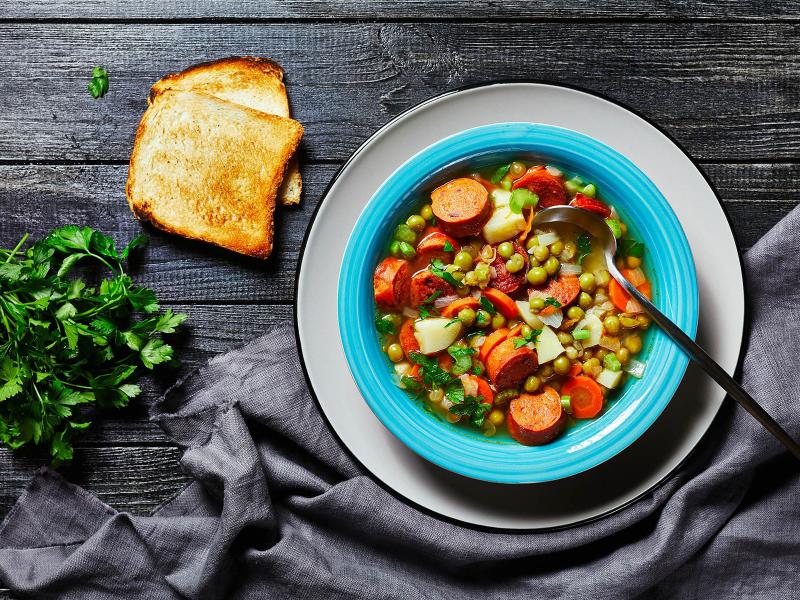
Quick & Hearty Turkey Kielbasa Soup
Macros / Serving Size
Protein 26g | Fat 26g | Carbs 31g
% Calories of Macros / Serving Size
Calories 448 | Protein 26% | Fat 51% | Carbs 26%
Nutrients / Serving Size
Fiber 5g | Sodium 1,490mg | Sat. Fat 8g
Ingredients (Servings 4)
- 12-13 oz package of turkey Kielbasa, sliced
- 1 tbsp. olive oil
- 1 large white onion
- 2 medium carrots, thinly sliced
- 2 cups chopped cabbage
- 2- 15-16 oz cans stewed tomatoes (no added salt)
- 4 cups low sodium chicken or vegetable broth
- 3-4 cloves garlic
- 2 bay leaves (optional)
- ½ tsp. red pepper flakes
- 10-12 oz frozen spinach leaves
- 1 cup egg noodles
- Pepper to taste (optional)
Directions
In a large Dutch oven or pot, bring the olive oil to temperature over medium heat. Add the white onions, kielbasa carrots, and cabbage and sauté until the onions become tender and the kielbasa is browned on each side. Add 1-2 tbsp. of broth, scrape the bottom and turn heat up to medium high. Cook until the carrots start to become tender and add the garlic, cooking for an additional minute.
Add tomatoes, broth, remaining spices and bring to a gentle boil. Add the noodles and spinach, turn heat to medium. Cover and boil until the pasta is cooked (about 5-7 minutes).
Serve 1/4th of the soup in a large bowl alongside a piece of fresh melon.
Nutrition Analysis based on the use of 12 oz of kielbasa and 10 oz. of frozen spinach. Optional ingredients are excluded from the analysis. This soup high in sodium due to the smoked sausage. Care should be taken to watch sodium consumption to keep intake below the recommended daily limit.
Tips
To lower sodium level and increase protein, consider using lean ground beef or turkey, draining fat instep one.
Nutrition Education
The Dietary Guidelines promote diets rich in nutrients by aiming to have at least half of a plate of fruit and/or vegetables. No medical professional would discourage eating more, especially vegetables. Dietary Guidelines do set maximum limits for some nutrients such as sodium. The body needs sodium. It is key in conducting nerve impulses, contracting and relaxing muscles and promoting a proper balance of fluids and minerals. The actual amount of sodium needed is approximately 500-600 mg per day for most Americans and more for those that are participating in strenuous physical activity and/or perspiring.
Studies show that too much sodium intake leads to an accumulation in the body which causes the body to retain too much fluid and may contribute to high blood pressure. High blood pressure could contribute to kidney disease, stroke and heart disease. To prevent this accumulation and poor health outcomes, the Dietary Guidelines for Americans recommends a daily limit of 2,300 mg, for most Americans, (your medical provider may recommend a lower level based on race, age, and/or medical condition). Most Americans still exceed this, even with the daily limit set at four times greater than the average needed. Many consume nearly double the daily limit. Although the soup in this featured TOTB is high in sodium, it is not off limits. Nor are other high sodium food choices. The key is to watch the portion size, and then balance other foods consumed throughout the day with lower sodium choices.
To work this soup in your day, build the rest this day’s intake around low sodium foods such as fresh fruit, fresh meats, poultry, and whole grains such as brown rice, quinoa, or oatmeal.
